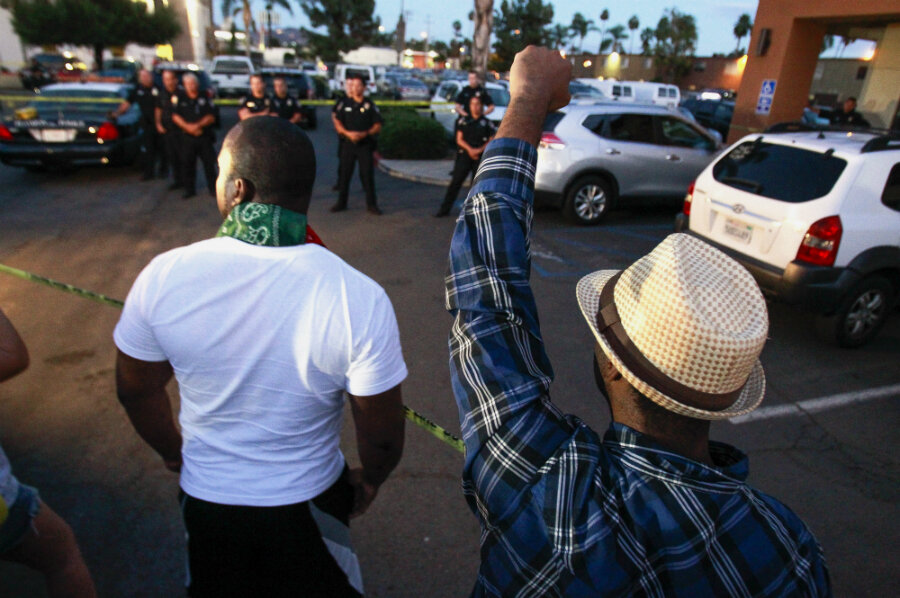How California police shooting of black man fits a national pattern
Loading...
Police called to a strip mall by a man's sister, who told authorities that he was "not acting like himself," killed a black man in the suburban San Diego community of El Cajon in California on Tuesday.
At a late night news conference, El Cajon police chief Jeff Davis told reporters that the man had pulled an object from his pocket – later acknowledged not to be a weapon – and pointed it at officers, according to the Associated Press. One of the officers, he said, tried unsuccessfully to subdue the man with a stun gun. When that failed, another officer discharged his weapon several times, killing the man.
Dozens of protestors met at the scene of the shooting after the death was announced. Police countered claims that the man had been shot with his hands up by producing a frame from a video taken by a bystander that showed the man in what they described as a "shooting stance" as officers approached.
Chief Davis called for the community to remain calm and pledged a thorough investigation of the incident. "This will be transparent," he said, according to the AP. "This will be looked at by multiple sets of eyes, and not just ours."
The shooting follows a pattern that by now has become tragically familiar in the United States – a police shooting, video captured by smartphones, and a quickly assembled protest. But it also touches on the twin pressure points of how race and mental health play into citizens' treatment at the hands of police. The California incident comes on the heels of recent police shootings in Tulsa, Okla., and Charlotte, N.C., that continue to place civilian deaths at the hands of police under national scrutiny.
Among other videos surfacing in the aftermath of the incident was one showing a woman who identifies herself as the man's sister and who appears distraught by his death, telling officers that her brother was mentally ill.
"I just called for help, and you came and killed him," she said, according to the AP.
Recent incidents have highlighted a lack of police sensitivity in dealing with those who struggle with mental challenges. In July, a North Miami officer shot a behavioral health therapist who was attempting to calm a man diagnosed with autism as he sat in the street, blocking traffic. The helper was struck in the leg by a bullet fired by police. Police said they had responded to a call of an armed man threatening suicide; the man had turned out to be holding a toy truck.
A few departments have taken steps to improve their responses in such cases. In June, The Christian Science Monitor reported that the Los Angeles police department had partnered with the local department of mental health, pairing beat cops with clinicians in cases where mental illness is suspected to be a factor:
By partnering beat cops with mental health clinicians, the MEU reined in costs associated with frivolous 911 calls. It also connected thousands of individuals with counseling and support, reducing incidences of force used on individuals with mental illness and alleviating the burden on overcrowded emergency rooms and the criminal justice system....
In recent years, US jails and prisons have become the nation’s de facto mental hospitals, advocates say. There are 10 times as many inmates diagnosed with severe mental illness in the penal system as patients in state mental institutes, the nonprofit Treatment Advocacy Center estimates. Just under half of those inmates are incarcerated for nonviolent offenses, according to the National Alliance on Mental Illness....
The LAPD deploys doctors, nurses, and social workers alongside patrol officers. At any given time, there are four or five officer-clinician teams patrolling together. For officers responding on their own, clinicians staffing a MEU triage desk are available 24 hours a day to consult.
Police have not released the full cellphone video from which the frame was taken and which was provided to them by a bystander. El Cajon police do not wear body cameras.
This report contains material from the Associated Press.








